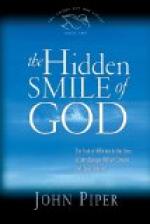a strict and holy life he lived in his days both in
word and deed.” Much as Bunyan tells us
he had lost of the “little he had learnt”
at school, he had not lost it “utterly.”
He was still able to read intelligently. His
wife’s gentle influence prevailed on him to
begin “sometimes to read” her father’s
legacy “with her.” This must have
been entirely new reading for Bunyan, and certainly
at first not much to his taste. What his favourite
reading had been up to this time, his own nervous
words tell us, “Give me a ballad, a news-book,
George on Horseback, or Bevis of Southampton; give
me some book that teaches curious arts, that tells
of old fables.” But as he and his young
wife read these books together at their fireside, a
higher taste was gradually awakened in Bunyan’s
mind; “some things” in them he “found
somewhat pleasing” to him, and they “begot”
within him “some desires to religion,”
producing a degree of outward reformation. The
spiritual instinct was aroused. He would be
a godly man like his wife’s father. He
began to “go to church twice a day, and that
too with the foremost.” Nor was it a mere
formal attendance, for when there he tells us he took
his part with all outward devotion in the service,
“both singing and saying as others did; yet,”
as he penitently confesses, “retaining his wicked
life,” the wickedness of which, however, did
not amount to more than a liking for the sports and
games of the lads of the village, bell-ringing, dancing,
and the like. The prohibition of all liturgical
forms issued in 1645, the observance of which varied
with the strictness or laxity of the local authorities,
would not seem to have been put in force very rigidly
at Elstow. The vicar, Christopher Hall, was an
Episcopalian, who, like Bishop Sanderson, retained
his benefice unchallenged all through the Protectorate,
and held it some years after the Restoration and the
passing of the Act of Uniformity. He seems, like
Sanderson, to have kept himself within the letter
of the law by making trifling variations in the Prayer
Book formularies, consistent with a general conformity
to the old order of the Church, “without persisting
to his own destruction in the usage of the entire
liturgy.” The decent dignity of the ceremonial
of his parish church had a powerful effect on Bunyan’s
freshly awakened religious susceptibility—a
“spirit of superstition” he called it
afterwards—and helped to its fuller development.
“I adored,” he says, “with great
devotion, even all things, both the High Place”—altars
then had not been entirely broken down and levelled
in Bedfordshire—“Priest, Clerk, Vestment,
Service, and what else belonging to the church, counting
all things holy that were therein contained, and especially
the Priest and Clerk most happy, and without doubt
greatly blessed because they were the servants of
God and were principal in the Holy Temple, to do His
work therein, . . . their name, their garb, and work,
did so intoxicate and bewitch me.” If




